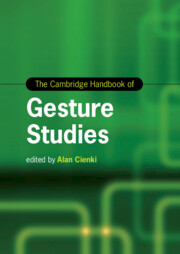Book contents
- The Cambridge Handbook of Gesture Studies
- Cambridge Handbooks in Language and Linguistics
- The Cambridge Handbook of Gesture Studies
- Copyright page
- Contents
- Figures
- Tables
- Contributors
- Introduction
- Part I Gestural Types: Forms and Functions
- 1 Emblems
- 2 Recurrent Gestures: Cultural, Individual, and Linguistic Dimensions of Meaning-Making
- 3 Iconicity, Schematicity, and Representation in Gesture
- 4 Indexicality, Deixis, and Space in Gesture
- 5 From the Neck Up: Facial Gestures in Dialogue
- Part II Ways of Approaching Gesture Analysis
- Part III Gestures and Language
- Part IV Gestures in Relation to Cognition
- Part V Gestures in Relation to Interaction
- Index
- References
1 - Emblems
from Part I - Gestural Types: Forms and Functions
Published online by Cambridge University Press: 01 May 2024
- The Cambridge Handbook of Gesture Studies
- Cambridge Handbooks in Language and Linguistics
- The Cambridge Handbook of Gesture Studies
- Copyright page
- Contents
- Figures
- Tables
- Contributors
- Introduction
- Part I Gestural Types: Forms and Functions
- 1 Emblems
- 2 Recurrent Gestures: Cultural, Individual, and Linguistic Dimensions of Meaning-Making
- 3 Iconicity, Schematicity, and Representation in Gesture
- 4 Indexicality, Deixis, and Space in Gesture
- 5 From the Neck Up: Facial Gestures in Dialogue
- Part II Ways of Approaching Gesture Analysis
- Part III Gestures and Language
- Part IV Gestures in Relation to Cognition
- Part V Gestures in Relation to Interaction
- Index
- References
Summary
Emblematic gestures (or emblems) have several denominations in the literature (for instance autonomous, quotable, semiotic, folkloric or symbolic gestures). Emblems are culture-bound gestures; they differ interculturally and intraculturally, both among different cultural and linguistic areas, and among individuals and social groups within the same culture. These gestures are easily translated into verbal language, they are quotable; they are equivalent to utterances, and in many cases, they have names. Typical emblems are used – alongside or without words – for greetings, insults or mockery, to indicate places or people (deictics), to refer to the state of a person (to be drunk, to be asleep …), to give interpersonal orders or to represent actions (to eat, to drink, etc.). Many emblems show a clear perlocutionary component (to offer, to threaten, to promise or to swear …). The tradition in the study of emblems has always emphasized their autonomy from speech (they are interpretable with a high level of context independence). Moreover, emblematic capacity can be regarded as associated with illocutionary force, which is one of the most characteristic features of these units.
Keywords
- Type
- Chapter
- Information
- The Cambridge Handbook of Gesture Studies , pp. 7 - 31Publisher: Cambridge University PressPrint publication year: 2024

